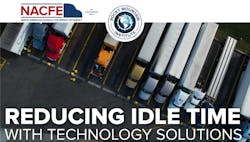Updated Confidence Report from NACFE on idle-reduction technologies
The North American Council for Freight Efficiency (NACFE) released an updated version of its Confidence Report on idle-reduction technology. Five years ago, NACFE’s first report on idle-reduction technology came out in June 2014 when fuel prices were above $4 a gallon. According to the report, though fuel prices are a major expense for fleets (22 percent of a fleet’s total operating costs), as of May 2019 fuel prices dropped to around $3.16 a gallon, therefore extending payback time for idle-reduction technologies.
When it comes to fuel savings, reducing idle time by just 10 percent is equivalent to about 1 percent in fuel economy, and that 1 percent is worth about $500-700 annually with fuel prices at $3 a gallon and traveling 100,000 miles a year.
“Depending on your starting point, a reduction of 20 percent (from 35 percent to 15 percent) is not unreasonable if the right combination of technologies is employed and managed,” the report states.
Aside from fuel savings, the report found many benefits to reducing idle time, including being good for the environment, reducing some wear and tear on the engine, and most importantly, driver hiring and retention.
“Idle reduction is an investment not in fuel reduction but in driver retention and driver satisfaction,” says Darry Stuart, president and CEO, DWS Fleet Management.
While drivers are in their vehicles, they want to feel comfortable, especially during their mandated rest periods. Having the ability to use their computers, gaming systems, microwaves, refrigerators, and charge their mobile phones, all without having to turn the engine on, helps to keep drivers’ satisfaction up. Drivers don’t like the noise and vibrations that come from idling.
Another important factor to pull from the report, says Denise Rondini, NACFE and Rondini Communications, is, “There is no one right solution when it comes to idle reduction.”
In fact, the report found that for fleets to get the most efficient and effective idle-reduction solution, they should try a combination of complementary technologies.
The report notes four anchor technologies – driver controls along with fuel-operated heaters, diesel APUs with fuel-operated heaters, battery HVACs along with fuel-operated heaters, and automatic engine start/stop systems – are best as the basis for a solution along with other technology to support the anchor.
No two fleets are the same. Each has its own goals and objectives when it comes to idle reduction. Luckily, there are many options for fleets to choose from, and after weighing the costs, benefits, and challenges of each, they’ll be able to find an optimal solution for their fleet.
To read the full report, visit nacfe.org/report-library.
About the Author
Emily Markham
Assistant Editor | Vehicle Repair Group
Emily Markham is an assistant editor for the Vehicle Repair Group.
With an education based in writing and editing, Markham uses her knowledge to assist with the creation of content for Endeavor Business Media Vehicle Repair Group’s publications—Fleet Maintenance, Professional Tool & Equipment News (PTEN), and Professional Distributor—as well as their website, VehicleServicePros.com.

